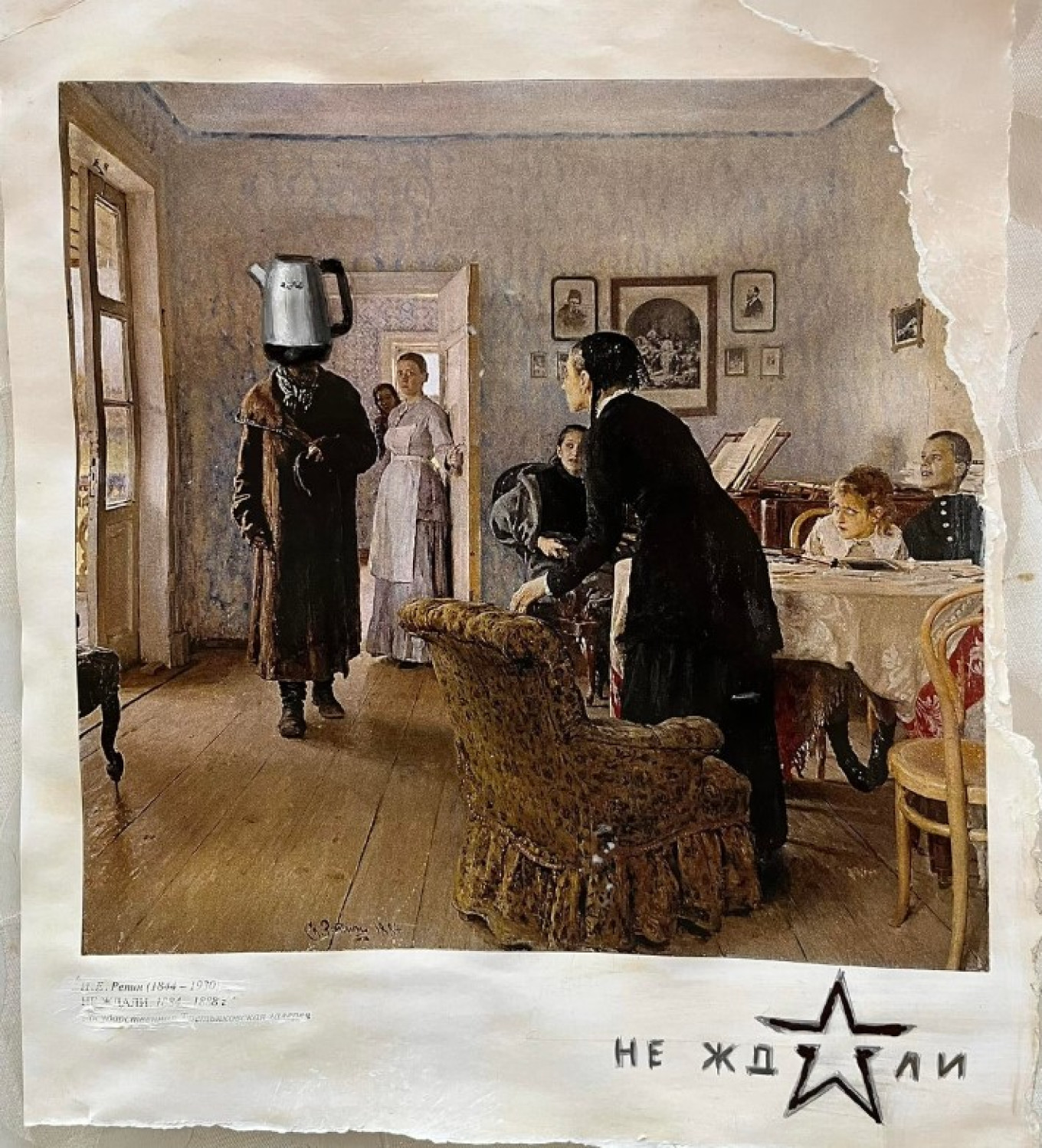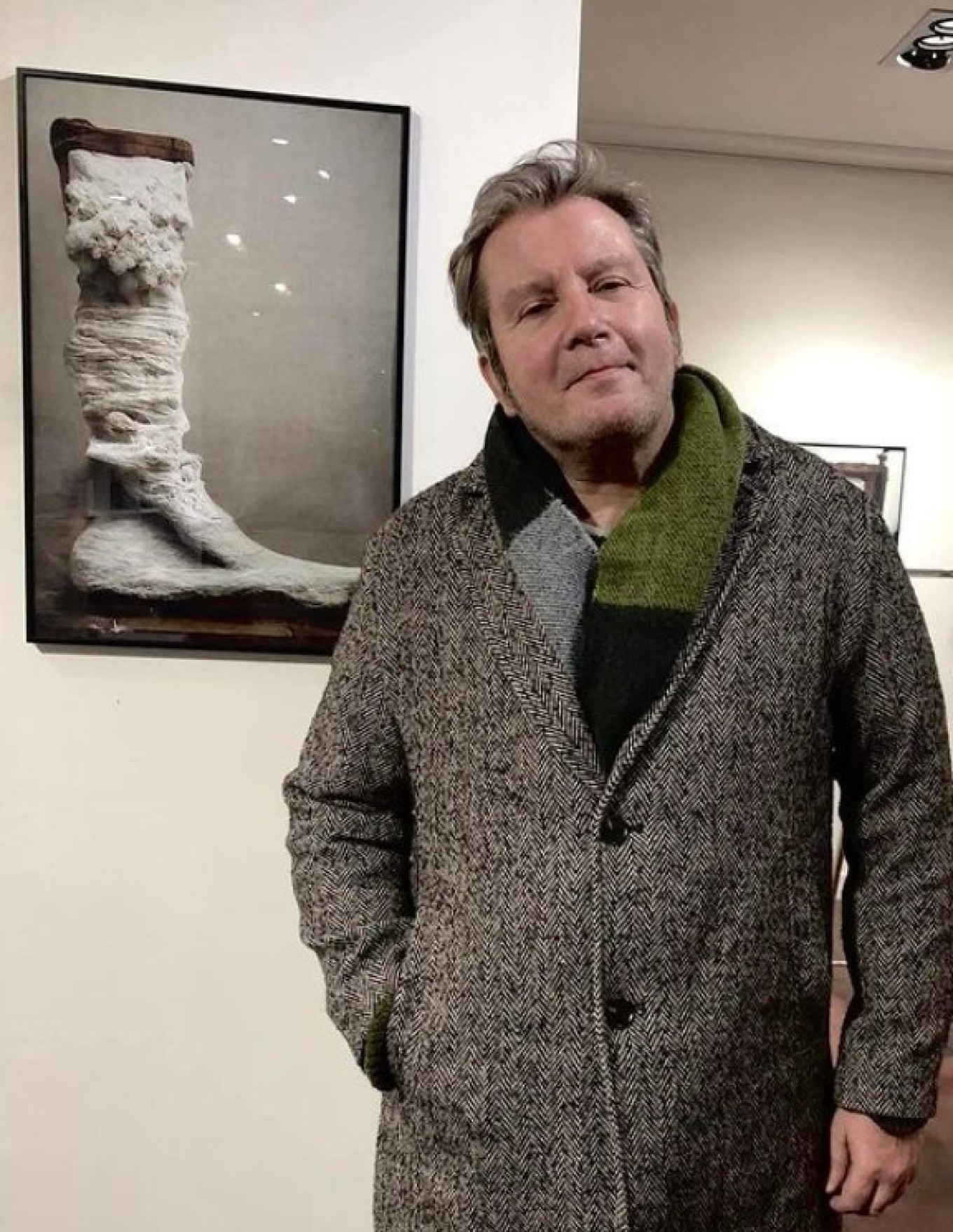For the last year, Igor Gusev has fought his own war against Russian imperialism. Gusev’s combat employs unusual tactics. His conflict is waged from home, and his weapon of choice is an Instagram series called “World War 3.”
Gusev, who was born in 1970 and has lived his entire life in the Ukrainian city of Odesa, was trained in Soviet art academies that largely promoted the notions of a “great Russian culture” — one the Soviet Union had inherited and preserved. While he was still in school, the Soviet Union disintegrated and Ukraine declared its independence. After 1991, he launched a career as a poet and artist who dabbled in films, art objects and installations. He first gained attention for his performance art and his ability to work in different media, with one critic calling him a “genius” who “would become the leader of the new generation of artists.”
Gusev became known for paintings that were playful and evocative, traits on full display in his 2017 exhibition, “A Glitch in the Painting,” where, as the press release states, he “blends traditional imagery of bourgeois society from within palace walls and enjoying scenes at the coastal promenades with a disruptive glitch of block color paint stripes.” But Russia’s invasion of Ukraine on Feb. 24, 2022 altered his artistic viewpoint.
With most shops — including art supply stores — closed, Gusev realized that he could not distract himself from the Russian bombs by painting. Then he stumbled upon a flea market selling Soviet-era books. Inside the volumes, he encountered the art history he had first learned as a kid and then as a young art student. An idea was born. He bought the books.
Looking through the volumes at home, he was struck by a reproduction of Ivan Aivazovsky’s 1850 painting “The Ninth Wave.” Aivazovsky, born Hovhannes Aivazian in 1817 to an Armenian family in Crimea, became extraordinarily popular for his paintings that romanticized the seas and the Russian imperial navy. “The Ninth Wave,” which depicts sailors trying to survive a shipwreck, is his best-known work. Originally purchased for Moscow’s Tretyakov Gallery, Emperor Alexander III acquired the painting for his collection, which became the basis for the State Russian Museum in St. Petersburg (where it remains on display).
Gusev tore the image out, scratched out the name of the artist, and drew a contemporary Russian battleship on long legs. He also added the words that had become famous when Ukrainian forces defending Snake Island uttered them to Russian invaders: “Russian warship, go f*** yourself.” Aizavosky’s stranded sailors were transformed into Ukrainian defenders. With nowhere to display the work, Gusev took a photograph and posted it on his Instagram page. His last prewar post received 36 likes. This one got 749. The “World War 3” series was born.
The series has several threads, including some using Soviet-era imagery. But it mostly focuses on the Imperial era, with three broad themes: famous 19th-century paintings, Russian writers and the two “Greats,” Peter I and Catherine II.
Several works transform 19th century paintings into contemporary commentaries about the behavior of Russian troops. In Gusev’s hands, Vasily Perov’s 1871 “Hunters at Rest” morphed into “special operation troops” lounging in the grass with dreams of fancy kitchen appliances in their heads. Vasily Surikov’s 1887 “Boyarina Morozova,” which depicts a 17th Century religious dissenter’s arrest, substitutes the woman of the title for a washer-dryer being looted. And Ilya Repin’s famous 1888 “They Did Not Expect Him,” featuring a revolutionary returning from exile, becomes the arrival of a nice teapot taken from a Ukrainian home.

Gusev also takes to task the way many Russians have ignored the “special military operation.” Aleksei Venetsianov’s “Sleeping Peasant Boy” (1823-26), which romanticized the pre-emancipation Russian peasantry, now has the young peasant bound to a tree, his eyes whited out. Gusev’s text declares: “We are Russians! We have Stockholm Syndrome!” Gusev substitutes the “s” for a “z” in a nod to the symbol that has become synonymous with support for the war. The beloved landscape painter Isaac Levitan’s “Above Eternal Peace” continues this criticism. The small, isolated Russian Orthodox chapel now has a word balloon above it stating “It’s Not Me.” At the bottom, Gusev ironically labels this thinking “the Russian idea.”
Nineteenth-century portraits of beloved Russian writers do not escape Gusev’s treatment. Gusev blots out the eyes in a reproduction of Orest Kiprensky’s 1827 portrait of the poet Alexander Pushkin, and adds the word “Russia” written with SS lighting bolts. Blood streams down the poet’s face. Both Tolstoy and Dostoevsky (or more accurately, their portraits) have their eyes altered in the series, suggesting that readers have found solace in their works while remaining blind to the empires that have promoted them.
Peter I and Catherine II may be “greats” in Russian historical memory, but they were also empire-builders responsible for the conquest of Ukrainian lands. Gusev takes the famous tapestry celebrating Peter the Great’s victory at Poltava in 1709, places a “Z” above the tsar’s head and adds a St. George’s ribbon, another symbol that the Putinist state has co-opted for its patriotic purposes. In the background, bombs drop on the Ukrainian land, making a visual connection to the attacks on Ukraine across the centuries. Catherine II, who eradicated the Ukrainian Cossack state, annexed the Crimean peninsula and established a colonial regime in Ukraine, morphs into an octopus, her tentacles symbolizing the hold of the Russian state over its conquered territory.
Gusev’s marked-up artworks force viewers to confront the legacies of Russia’s colonialism in the region, and how art smooths over the memory of violent conquest. By using books largely printed in the Soviet era, Gusev points to a larger project in which the Russian state conquered territories and then Russified them through cultural imperialism. In his Instagram series, Gusev is dismantling the “great Russian culture” notion propagated in the 19th, 20th and 21st centuries, one painting at a time.
Igor participated in a Zoom event in April 2022 dedicated to Ukrainian artists during the war. His power went out at one point, a stark reminder of the realities he faces. When he initially agreed to participate, he noted that he occasionally needed to take refuge in bomb shelters, and might have to do so during the call. In this environment, he says, using his brushes and pens to fight World War 3 has a calming effect.

“When we were growing up,” Gusev said at the event, “these artworks were in almost every textbook.” Now armed with them, Gusev says that his main task is “to create immediate narratives,” something he terms “rapid reaction art.” The war has created “an alternate consciousness” for Ukrainian artists, one where you have to balance air raid sirens and explosions with a desire to reinterpret everything, including “our attitude toward culture and society.” He hopes that Russians will see the connections he is attempting to make, although he doubts the message will be accepted. In the meantime, the “World War 3” series, just like Putin’s war, continues.





